|
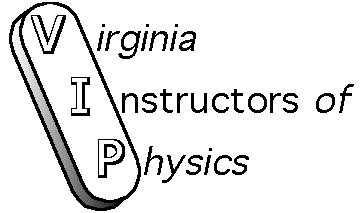 Winter
edition '99 Winter
edition '99
VIP's mission is to foster communication among teachers of
physics and physical science as well as to provide unique learning
experiences for teachers and their students.
Back to the VIP Homepage.
A note from the President
Hi. Last year at the spring meeting of VIP, we held our annual
elections. Tony Wayne, who has served as our president for several
years had chosen to step down and I was elected to the position. I
was vice president under Tony for the last few years so that position
also came open. Thomas O'Neal was elected to to serve you in that
capacity.
I thought it may be useful to introduce myself to those who don't
know me and describe my background. I have been a member of VIP since
its very earliest days. This is my twelfth year of teaching. I taught
my first six years at Fauquier High School in Warrenton , and then
moved to my present position at Harrisonburg High School in
Harrisonburg. I have a B.S. in Physics from James Madison University.
Since receiving my degree I have continued to learn a great deal. I
have learned some from classes, much from my students and a great
deal from other dedicated professionals who are willing to share a
few of the gems from their personal bag of tricks. It is this sharing
attitude that has brought me back time and again to the VIP meetings.
I would like to publicly thank Tony for his years of leadership to
VIP and for the dozens of great ideas he has given away to all of
us.
Tony and a few individuals have carried VIP as far as contributions
to share are concerned. It is my goal to encourage a wider base of
contributors. VIP charges no dues. Its expenses are covered by UVA
(and JMU during some years in the past.) What I ask of you is to dig
into your archives and share your best. It does not have to be an
original idea. If you know a book, a piece of equipment or an
experiment that works just right, bring it along to share. VIP can
only be as good as the members who bring ideas to share. In the past
it has been great. It can get even better. At our spring meeting
bring an idea to share and a teacher from your area who might enjoy
the meeting. See you on March 27.
Sincerely ,
Andy Jackson
All of the labs and ideas in this newsletter
were contributed by me, Andy Jackson. I hope this will not be the
case in the future. For VIP to continue, we need many members to
share their ideas. Please send me your contributions to the next
newsletter. You may e-mail me at asjackso@pen.k12.va.us
or jacksonhhs@hotmail.com.
You can send them to me by mail
at:
Andy Jackson
Harrisonburg High School
395 South High Street
Harrisonburg, VA 22801-1956
It is especially true in the case of VIP
that "all of us are better than any one of us".
On the next three pages I have included a project and a lab that I
use during the first grading period. The project is one I read in
The Physics Teacher about ten years ago and I
don't know the name of the person to give credit to. I created the
application and came up with the list of physicists. If you come up
with other interesting physicists that you think I should add to the
list, I would love to hear from you.
The lab has the students use a sonic range finder, a TI-83, CBL and
their bodies to make graphs. It generates a lot of excitement and
really has the students explore their knowledge of motion. Some of
these drawn shapes are easy to match and some you have to be quite
lenient with. The acceleration graphs that can be generated using the
sonic range finder are very rough and so a generally correct shape is
usually all you can look for.
Hall of Fame Project
Each student picks a number between 1 and 33 and is given the name
of his/her physicist. The student is then given the application. The
assignment is to research the physicist well enough to accurately
complete the application. At the end of the grading period I
interview each "physicist" for about 5 minutes. The student is to
portray his/her physicist as authentically as possible. This project
has been a favorite of mine for many years. It is great to here kids
five and six months later proclaim during a lecture "hey, he was my
physicist!" It has also been a big hit with two different
administrators during observations.
- Nikola Tesla
- Tycho Brahe
- Marie Curie
- Albert Einstein
- Stephen Hawking
- Richard Feynman
- Albert Michelson
- Robert Goddard
- Isaac Newton
- Edward Teller
- Edwin Hubble
- Johannes Kepler
- Robert Millikan
- Werner Heisenberg
- Cecilia Payne-Gaposchkin
- Thomas Young
- Galileo Galili
- Chien Shiung Wu
- Ernest Rutherford
- Wolfgang Pauli
- Thomas Edison
- Luigi Galvani
- Alessandro Volta
- Nicholaus Copernicus
- Charles Coulomb
- Michael Faraday
- Joseph Henry
- Murray Gell-Mann
- Robert Hooke
- Christian Huygens
- Erwin Schrodinger
- James Clerk Maxwell
- Heinrich Hertz
- J. Robert Oppenheimer
- Benjamin Thompson
Sonic Ranger Activity
Use the TI-83, CBL and ultrasonic range finder to make motion that
matches the shapes of the following graphs. NUMBER A PAPER FROM 1-15
AND GET ME TO CHECK OF EACH ONE AS YOU GET IT.
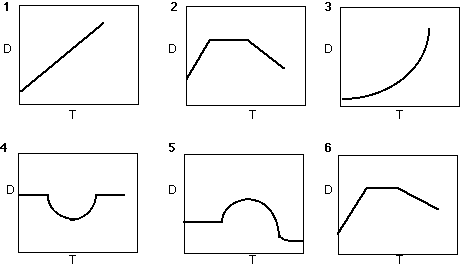
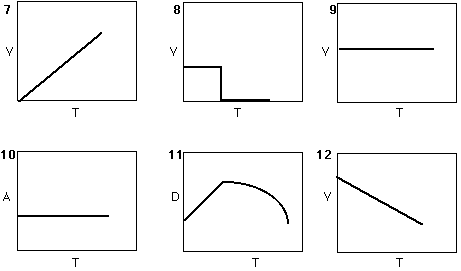
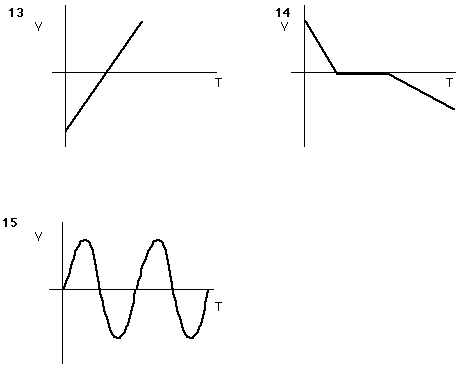
Now sketch a D Vs T , V vs T, and an A vs T graph for each of the
following; 1,4,7,10,13 and 15.

|
A Note to
teachers
I hope you enjoy this one. I have had department members
report to me how excited some students were about this lab.
They continued talking about it, asking each other questions
about "how did you get . . ." and "Could you get the one
that went ...?" When I hear comments like that, I know I've
got a keeper. |
Acoustical Study of an Auditorium
|

|
Name_________________
To the left is a scale picture of a high school
auditorium. You'll notice that the ceiling is shaped rather
oddly.
1- Draw the path that sound travels in the
auditorium as it leaves the speaker's mouth
on stage and reflects off of the ceiling at the
numbered points. Areas that are crosshatched
absorb sound.
2- Explain why the ceiling is shaped this way.
3- Explain why the back wall of the auditorium
is designed to absorb sound.
4- Which ceiling sections should also be designed
to absorb sound to help deaden the sound
from the audience? |
|
A note to the teacher
This work sheet can be solved with a ruler, a
protractor, and knowledge of the law of reflection. Students
seem to like this low tech application. |
SAILING THROUGH
PHYSICS
|
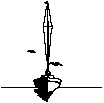
|
"I find the greatest thing in this world is not so much
where we stand, as in what direction we are moving: ...we
must sail sometimes with the wind and sometimes against it-
but we must sail, and not drift, nor lie at anchor."
- Oliver Wendell Holmes
The Autocrat of the Breakfast Table (1858)
|
Sailing is probably one of the most enjoyable vector problems you
can do. Since my yacht is undergoing repairs, we'll sail in the class
room.
PROCEDURE- Create a sailing ship with styrofoam, paper, dowel
rods, string, a plastic ruler and tape. You may wish to consult How
things Work to see how real ships are designed.
GOAL 1- Make your "ship" sail with the wind. Try to arrange
the sail so the "ship " goes as fast as possible.
Goal 2- Arrange your sail so your "ship" will sail at right
angles to the wind.
GOAL 3- Arrange your sail so your "ship" will go upwind.
Now read appendix D of Conceptual Physics
Analysis
- Describe how a ship can meet each of the four goals. Use force
diagrams (like in Conceptual Physics) to aide your
explanation.
- Is it possible for two ships to go in exactly opposite
directions using the same wind? How?
- In which of these three situations would a ship be able to
reach the highest speed? Explain your answer.
- If a ship was at rest with its sails down, in which of these
three situations would it be able to have the greatest
acceleration upon raising its sails? Why?
A note to the teacher - This lab is messy and time consuming. It's
also not the fastest way to get these ideas across, but you've got to
see the excitement when kids see their boat sailing into the
wind. The equipment you need for this is as follows.
- A large container for water. I use some stream tables from
earth science. They are about 1 m x 30 cm x 5 cm.
- A source of wind. I use some old hair dryers on low
power.
- Sheets of styrofoam insulation. 8
- Scalpels or other tools for cutting the styrofoam.
- Materials for masts and booms. I use thin dowel rods cut to
about 20 cm lengths.
- Materials for keels. Most of my students don't initially see
the need for a keel. (note: We live in the mountains, sailing is
not something many of my students have a lot of experience with.)
I allow them to discover the need. I supply 6 inch Cenco flexible
rulers for this use.
- String, tape and paper are used to construct the sail
http://www.uwrf.edu/college-of-education/goals2000/science.html
- A large collection of science links
http://www.pen.k12.va.us/Anthology/Pav/Science/Physics/
- Our very own web site! Bookmark this for VIP info.
(Home of the free book, Roller Coaster Physics.)
http://www2.gsoc.dlr.de/scripts/satvis/satvis.asp?Lat=38.5&Lng=-78.833&Loc=Harrisonburg&TZ=EST
- My current favorite! This site gives you exact coordinates and
times for you and your students to see satellites, sometimes in
broad day light. I'm still trying to figure out how to make a good
lab or two out of this. Currently this URL is for Harrisonburg's
location but you will be able to edit it to suit yourself.
MARCH 27 AT
UVA'S PHYSICS BUILDING SPRING MEETING
SCHEDULE |
|
9:00 - 9:30 |
Hello's |
|
9:30 - 10:30 |
VIP Business, Election of officers, Future directions of
VIP, Affiliation with VAST, ?. . |
|
10:30 - 11:30 |
General demonstrations and lesson plans to share |
|
12:00 - 1:30 |
Lunch (You are on your own). |
|
1:30 - 3:30 |
Lab share: What are you and your students doing with
graphing calculators? |
There is no fee and there are no dues, just come and
enjoy!
Please bring an idea, lesson plan, demo or experiment to share
(~50 copies). Also, consider bringing another teacher who might
benefit.
Have a piece of equipment you don't know how to use (or what it
is)? BRING IT !!! See if you can stump the experts (who ever
they are) or get some help. I personally will bring 1 of 12
beautifully made . . .?
Feeling Stressed?
This list of causes of stress in the workplace was in an article
printed in the winter edition of HealthQuest, a publication produced
by Rockingham Memorial Hospital. The author is Larissa Ivanitch.
Lifestyle and Job Stress
- Too much or too little work
- Having to perform beyond your experience or perceived
abilities
- Having to overcome unnecessary obstacles
- Time pressures and deadlines
- Keeping up with new developments
- Changes in procedures or polices
- Lack of relevant information, support and advice
- Lack of clear objectives
- Unclear expectations of your role from your boss or
colleagues
- Responsibility for people, budgets, or equipment
- Career development stress
- Stress from your organization or clients (demands from
clients, disruptions to work plans, pressures from your boss)
- Personal or family stresses (financial problems, health,
relationships)
It seems to me that according to this article I should be feeling
stressed. The article also contains tips on how to manage stress. I
have found in the past that a Saturday spent with fellow teachers at
VIP meetings is a great stress relief, social event, and learning
experience all rolled into one. Come join us.
Back to the VIP Homepage.
|